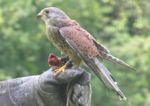Difference between revisions of "Avian Oral Cavity - Anatomy & Physiology"
Jump to navigation
Jump to search
m (Text replace - "Lips - Anatomy & Physiology" to "Lips") |
m (Text replace - "[[Cheeks - Anatomy & Physiology" to "[[Cheeks") |
||
| Line 10: | Line 10: | ||
==Introduction== | ==Introduction== | ||
| − | In avian species, the [[Lips|lips]] and [[Cheeks | + | In avian species, the [[Lips|lips]] and [[Cheeks|cheeks]] are replaced by the [[Skin - Anatomy & Physiology#Cutaneous Appendages|beak]]. |
The [[Skin - Anatomy & Physiology#Cutaneous Appendages|beak]] is an area of dense, horny skin overlying the [[Skull and Facial Muscles - Anatomy & Physiology#Incisive Bone (os ncisivium)|incisive bones]] of the [[Skull and Facial Muscles - Anatomy & Physiology#Mandible (mandibula)|mandible]]. | The [[Skin - Anatomy & Physiology#Cutaneous Appendages|beak]] is an area of dense, horny skin overlying the [[Skull and Facial Muscles - Anatomy & Physiology#Incisive Bone (os ncisivium)|incisive bones]] of the [[Skull and Facial Muscles - Anatomy & Physiology#Mandible (mandibula)|mandible]]. | ||
Revision as of 11:47, 3 September 2010
|
|
Introduction
In avian species, the lips and cheeks are replaced by the beak.
The beak is an area of dense, horny skin overlying the incisive bones of the mandible.
No modern birds possess teeth, however rudimentary enamel organs have been discovered in the embryos of some birds.
The size and structure of the avian tongue varies between species; it is related to the functional requirements of each species.
The avian hard palate contains a slit-like opening called the choanal opening which communicates with the nasal pharynx.

